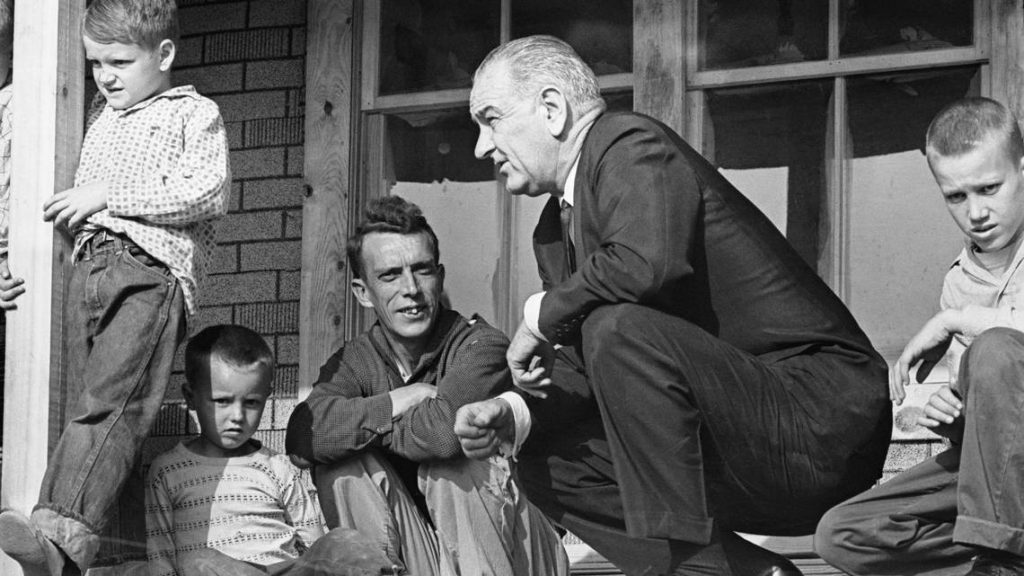
In the 1960’s, over one fifth of the population was living below the poverty line.
They were the invisible poor, unskilled workers, migrant farm workers, minorities, people for whom work was sporadic, demeaning and demoralizing.
They were damaged in body and spirit, existing at levels beneath those necessary for human decency.
They were hungry when they weren’t starving, or sometimes fat with hunger, for that is what cheap foods do.
They were without adequate housing and education and medical care.
They were mothers, fathers, sisters, daughters and sons.
They were Lyndon B. Johnson.
President Johnson grew up knowing struggle and difficult decisions one had to make to make ends meet. When he graduated from Southwest State Teachers College (now Texas State University) in San Marcos, Texas, in 1930. To help pay for his education, he taught at a school for disadvantaged Mexican-American students in south Texas. His first-hand experience and look at the effects of poverty and discrimination on his students made a deep impression on Johnson and sparked in him a lifelong desire to find solutions to these problems.
War on Poverty
Throughout government history, there have been many instances of laws and opportunities attempting to address the most vulnerable populations of our country. The War on Poverty began with the introduction of the office of Economic Opportunity. This office, established in 1964 by R. Sargent Shriver as part of the United States President Lyndon B. Johnson’s “Great Society” agenda, was created to address the 19% of Americans that fell below the U.S. poverty line.
Inspiration for Solution
This new office equipped with proposals gathered by recently assassinated President John F. Kennedy’s economic advisors, created programs such as Head Start, Food Stamps, Social Security, Job Corps, and Community Action Programs through the Economic Opportunity Act of 1964.
President Johnson stated, “The Act does not merely expand on old programs or improve what was already being done. It charts a new course. It strikes at the causes of poverty…Not just the consequences of poverty.”
This Act launched local federally regulated/funded agencies as part of the War on Poverty with the purpose of eliminating poverty, expanding educational opportunities, increasing the safety net for the poor and unemployed while tending to the health and financial needs of the elderly.
These Community Action programs were innovative because they gave control to local governments to target population needs, in comparison to previously federally addressed issues. Although constantly criticized by the federal government, Community Action remains an important safety net for many vulnerable individuals and families, even today.
Community Action: Our Solution
Community Action Agencies address poverty-the systemic problem-with a systemic approach. Its local response to needs provides the insight for actually making a change. Approaches are able to be flexible and coordinated with the client’s long-term development in mind.
Today this approach to addressing poverty was able to be seen in the fluctuation of our Community Service Block Grant funding through our FsACE program to address Cook County households in crisis due to COVID-19. In the face of this pandemic, we were able to survey our communities and in response to their needs and reallocate funding for assistance that is going to serve them most right now. Community Actions make that possible.
May is Community Action Month!
During this month across the nation, Community Action Agencies showcase the positive impact our programs and services have on the thousands of families we assist each year.
Learn more about Community Action on our website HERE!
Join us and stay tuned for more to come:
- CONNECT WITH US: Sign-up for our eNewsletter
- FOLLOW US ON SOCIAL MEDIA: Each week there are scheduled activities and ways for you to learn and show your support. Connect with us HERE!
- SHARE YOUR THOUGHTS: Tell us what Community Action means to you and your community. Leave your notes in the comment section below.